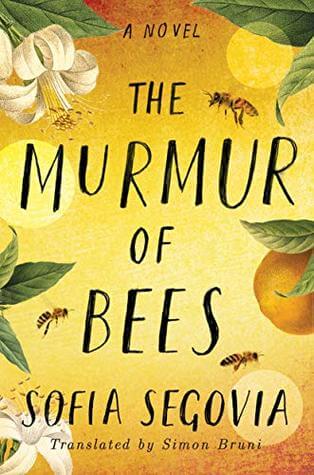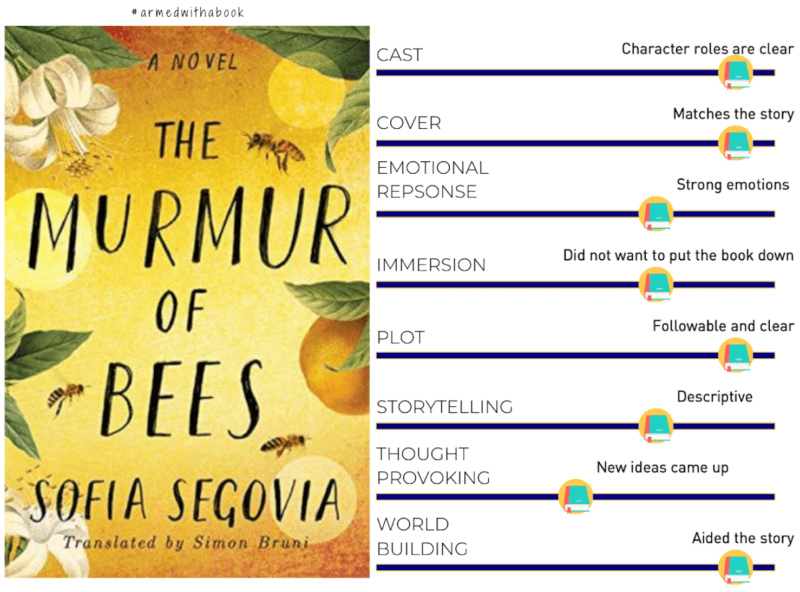For one second buddy read this year, Stephen and I decided to pick up The Murmur of Bees by Sofía Segovia, translated by Simon Bruni. I love translated books and though I don’t come across them often, they have a whole other level of immersion. A 100-chapter book, The Murmur of Bees is a heartwarming tale about a family in Mexico. In this post, I’ll share my thoughts and reading experience as well as a portion my discussion with Stephen for some of the chapters. Head over to Stephen’s blog for his thoughts and further discussion. But first, take a look at the book blurb below.

From a beguiling voice in Mexican fiction comes an astonishing novel—her first to be translated into English—about a mysterious child with the power to change a family’s history in a country on the verge of revolution.
From the day that old Nana Reja found a baby abandoned under a bridge, the life of a small Mexican town forever changed. Disfigured and covered in a blanket of bees, little Simonopio is for some locals the stuff of superstition, a child kissed by the devil. But he is welcomed by landowners Francisco and Beatriz Morales, who adopt him and care for him as if he were their own. As he grows up, Simonopio becomes a cause for wonder to the Morales family, because when the uncannily gifted child closes his eyes, he can see what no one else can—visions of all that’s yet to come, both beautiful and dangerous. Followed by his protective swarm of bees and living to deliver his adoptive family from threats—both human and those of nature—Simonopio’s purpose in Linares will, in time, be divined.
Set against the backdrop of the Mexican Revolution and the devastating influenza of 1918, The Murmur of Bees captures both the fate of a country in flux and the destiny of one family that has put their love, faith, and future in the unbelievable.
Content Notes: Murder, Pandemic sickness, Grief.
Themes for Thought
The Murmur of Bees introduces the reader to a number of characters. This can feel overwhelming in the beginning but they are connected in a delicate manner that over time, as I immersed myself more and more into this book, I liked having all of them around. This book as a whole is a fantastic read and there were three aspects that I enjoyed the most:
On Strength
The Murmur of Bees has some timeless characters. The story begins with Nana Reja who has been a nurse to many children in town, and now lives permanently with the Morales family. Simonopio is found in the fields as an infant and though Nana Reja does not take the role of his mother – Beatriz is his godmother – she has an important silent presence in his life.
Beatriz is one of the most powerful women characters ever written in my mind. I learned about Beatriz and how she grew up, her motivations in life, and throughout the story, I saw her confront grief, evolve as a leader and make hard decisions for her family. She loves Simonopio, and though sometimes her decisions make him unhappy, he is quite understanding of her. Beatriz is an amazing woman and there is so much strength in her, even in grief. She regrets certain things but that does not stop her from doing what she can.
On Learning Another Language
Simonopio and Francisco Junior have a very special bond. They are practically brothers. Simonopio knows that he is different from other people and it was interesting to read him imparting other knowledge to Francisco Junior, knowledge that other people just don’t listen for. Their relationship is another beautiful aspect of this book.
As you might recall from the book blurb, Simonopio is disfigured. He does not speak much. But when Francisco is born, the two share a language. Francisco understands what Simonopio is saying and he becomes an interpreter.

On Intuition
We know Simonopio is special. He has premonition about certain things and I really like how easily the Morales family accepted his gifts. He is friends with bees. He is a free spirit that Beatriz does not try to domesticate. There are some things though that turn up on Simonopio’s radar too late. And this leads the reader into the commentary around regrets and guilt. Knowing that one has the insight or power has the potential to make one regret not being on time.
The Murmur of Bees Chapters 16-30 Discussion with Stephen
Stephen: The pace of this story is quite slow, but the writing is truly exquisite. There are so many passages I could highlight, and there was one quote that stood out in particular, which I have pasted below. At times it reads almost like a fable or a fairytale, with its great storytelling. What do you think of it, Kriti?
Me: Yes, it does feel like that and that might also be because of the different point of views in the story. Most of it is in third person and I like when the narrative shifts to first person. I have highlighted a bunch of passages too!
Stephen: I’m glad that the last few chapters have focused more on Simonopio. His independence seems to be growing and he is developing a greater connection with nature than any human. The bees are guiding him somehow. All the same, I really like how much Francisco and Beatriz love him and care for him. I like Beatriz a lot as a character. What have you made of the family dynamic?
Me: It’s good to finally focus on him more. I was thinking about how much the godparents care about him. They understand him like their own child but he is just free of obligations like going to school. He is a free spirit and they know that and encourage it.
Stephen: I really like that. They understand that Simonopio is different to other children and they respect that.
I’m interested to see how Anselmo’s storyline will develop. He thinks Simonopio is the devil and blames him for his suffering. I wonder how far he will go to get ‘revenge’?
Me: I am interested to learn about that too. Relating this to your quotes below, there is a connection between the two which isn’t completely clear yet. I don’t quite understand why Anselmo feels so strongly about Simonopio – it was just a baby when they met. Does ‘the mark of the devil’ have a strong religious grounding? I think Simonopio offers Anselmo an outlet – an excuse for his own situation. To me, logic defies why and I am hoping that this will unravel itself in the next set of chapters.
Stephen: I think a lot of that is based upon superstition. In the past, some believed that mysterious events or people with disabilities carried the mark of the devil. It is, as you say, completely illogical and hint towards a lack of education on Anselmo’s part.
Here is my favourite quote:
“It was a story that was waiting patiently. Waiting to exist. This he knew with certainty. He had always known it, just as he knew the likely stories of others; all he had to do was search the corners of his mind to see them- his own stories or those of other people. Some stories – whether his own or not – he saw very clearly from start to finish. In certain stories, he could make out how they came to be before they had begun though he did not have a clear picture of the outcome. Other stories materialised from nowhere, with no warning; they just happened.”
I also liked this one, from the next page:
“Simonopio knew there were stories that one could read in books,with black words on white pages. He was not interested in those, because once printed they were indelible, unchanging. Each reader had to follow the order of words indicated in those pages exactly, until they each arrived at inevitably the same outcome.”
Me: This quote in particular speaks volumes to us readers and writers. 🙂
Though this book started at a slow pace, it did a phenomenal job of world building as well as the characters. I loved how immersive and detailed the writing was. It reminded me of the times I used to read as a kid – no matter how long a book took, I would stick to it and stay in the story. I liked the varying length of chapters as well. This is one of my favorite books this year! I am glad that we chose it and we took the time to read and discuss it.
There is so much more I want to say about this book but I need to let you discover it for yourself!
** The Murmur of Bees is now out in stores so get a copy and let me know what you think! **
Amazon Print
Amazon Kindle
(available on Kindle Unlimited)

Are you going to read this book with a buddy too? Stephen and I discussed the story after Chapters 15, 30, 45, 60, 80 and 100.
Cover image from Unsplash

This sounds magical! Though, as someone allergic to bee stings, I feel a little faint at the image of a baby being covered in bees…even benevolent bees 😨😄
Haha I can see that! Bees don’t hurt Simonopio or those he cares about so it’s good to be on his good side. 😀
Well, that’s definitely confirmed I need to move this one to the top of the TBR pile. Great review, Kriti 🙂
Thanks, Chris! I am sure you will enjoy it! Looking forward to hearing your thoughts on the book. 🙂
I just finished the book this morning. Captivating and so beautifully written, I agree, there are so many passages a reader could highlight. The description of life under the Spanish flu pandemic was prophetic and quite chilling in the light of all our experience. Definitely one of the books that will stay with me for a long time. Thanks for the recommendation, Kriti 🙂
I am glad it resonated with you, Chris. I feel the same about this book. It’s on my collect list. 😊